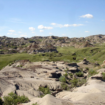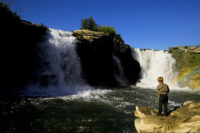Bears differ by region, SACPA told
By Tim Kalinowski on December 12, 2020.
 Herald file photo by Ian Martens
A black bear looks from a perch among the limbs of a poplar tree along the Red Rock Parkway in Waterton Lakes National Park. @IMartensHerald
Herald file photo by Ian Martens
A black bear looks from a perch among the limbs of a poplar tree along the Red Rock Parkway in Waterton Lakes National Park. @IMartensHeraldLETHBRIDGE HERALDtkalinowski@lethbridgeherald.com
Bear specialist, zoologist, wildlife consultant and author Sarah Elmeligi spoke about the importance of bear-human co-existence at the Southern Alberta Council on Public Affairs’ weekly YouTube livestream speaker series on Thursday.
Elmeligi took the opportunity to read excerpts and show photographs from her new book “What Bears Teach Us.”
Elmeligi said the first thing to note is every bear is different and has a distinct personality, and their responses to humans will be largely dictated by that personality and what kinds of experiences the bear has had with human beings in the past.
“Bears, particularly those living in high human-use areas, show incredible patience,” she said. “I am often amazed by how few bear attacks there actually are when I consider human behaviour in bear habitat. I giggle at the thought that I would make a bad bear because I would bluff charge too many people for violating my personal space while I was trying to eat lunch.
“There are many questionable things people do to get close to a bear for a photo or a story to tell their friends. Many people get far too close, and most of the time the bear does nothing. Few people would be as patient and tolerant as an Alberta bear if they had dozens of people closing in on them to take a photo while they were eating.”
She said in studying different bear populations in British Columbia’s coastal region, Alberta’s interior region, and the high northern forests in the Yukon she has come to realize bear behaviour is quite distinctly different depending on where they live.
In the coastal region, she explained, the abundance of salmon has made bears there more tolerant of the presence of people, and other bears, because there is no need for competition for resources. In the Yukon, bears are more populous in the landscape than people, and they set firm barriers on what they will accept of human behaviour in their presence, and what they will not. They are more likely to bluff charge and threaten if they perceive the human beings to be breaking these unspoken rules,” she said.
In Alberta, where people are abundant and resources relatively scarce, bear behaviour is much harder to predict, explained Elmeligi, because human behavior is also more intrusive and more erratic.
“In human-dominated landscapes like Alberta human use is less predictable, resources are scarcer, and bears are less tolerant,” she summarized. “In protected areas people can be on any road or trail at almost any time. This lack of predictability means bears don’t always get to decide when and where to access habitat in the absence of people.
“No matter how you look at this landscape it is sub-par at best,” Elmeligi stated. “With less food, bears need to wander farther distances to find it — which means they expend more energy. This also means there is more competition between bears. Thus there is more at stake, and bears are less tolerant of being disturbed by people and other bears.”
Elmeligi said the biggest risk for bears and people in Alberta is when bears become habituated and food-conditioned from being around humans.
“In these landscapes we often aim to avoid bears becoming habituated because those that do may have a higher risk of becoming food-conditioned,” she explained. “Once that is the case management action is almost always required to ensure public safety. To prevent bears from becoming food-conditioned managing agencies usually have plans in place to discourage bears from coming near human developments, but it does not address the human behaviour which may be the root of the problem.
“Wildlife management is usually just as much people management,” she added. “If we are going to effectively manage bear co-existence we need to consider, in effect, we will be managing people. Rarely do we manage bears directly.”
True co-existence, summarized Elmeligi, between humans and bears means in many cases human beings will have to be the ones who change their behaviours. In Canmore where she lives, for instance, the community uses bear-proof trash cans, forbids outdoor composting, and prevents people from keeping trees in their yards with hanging fruit on their branches.
“Throughout my research I have learned regardless of where you are, and what bear population you are working with, the human experience is an essential part of the encounter,” she said. “Co-existence is defined by us; how we perceive the risk and outcomes of these encounters.
“It is easier to ask people to cut down a crabbe apple tree in their yard,” she explained, “than it is to ask a bear not to eat delicious crabbe apples.”
Follow @TimKalHerald on Twitter
4-3




